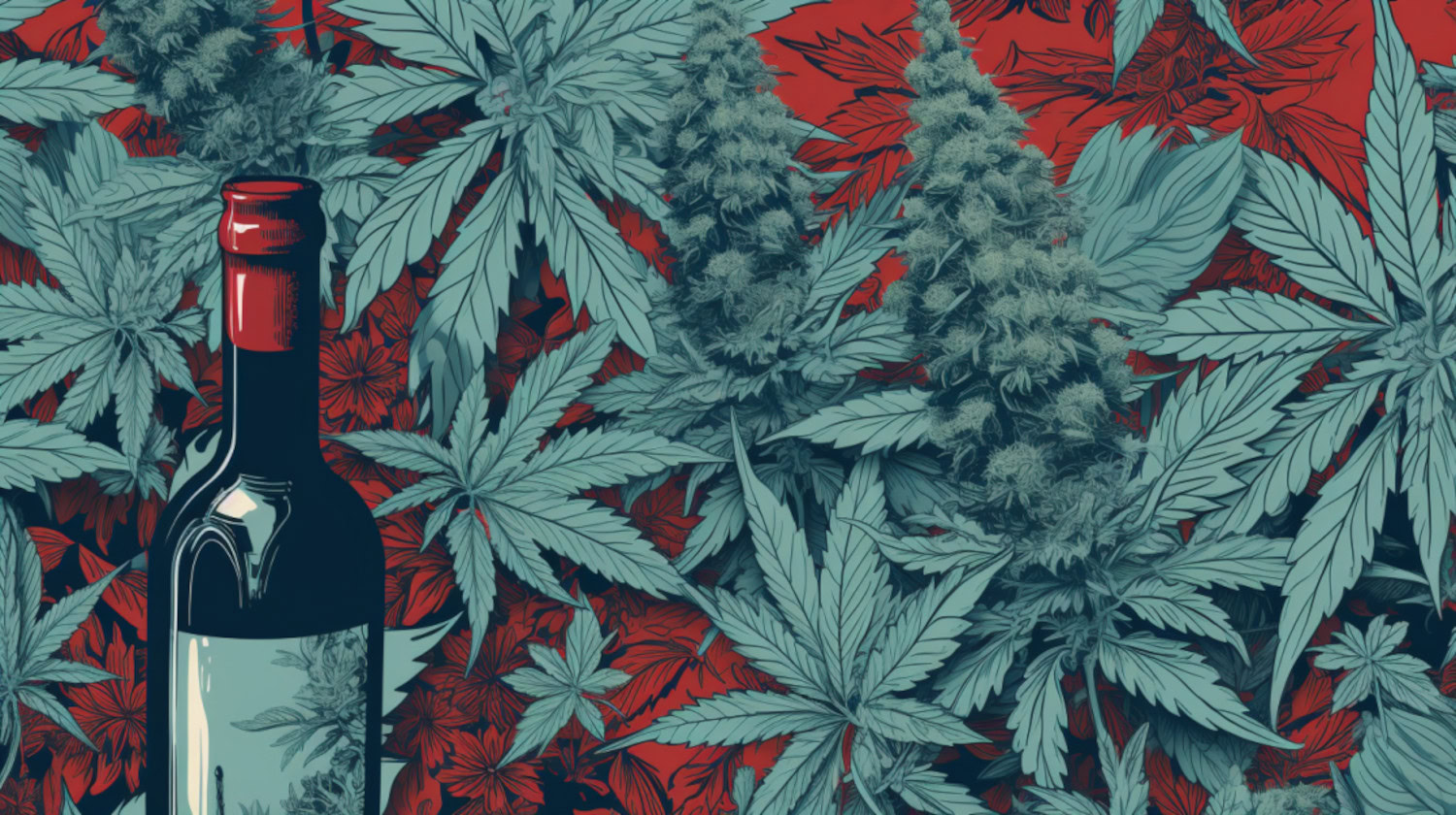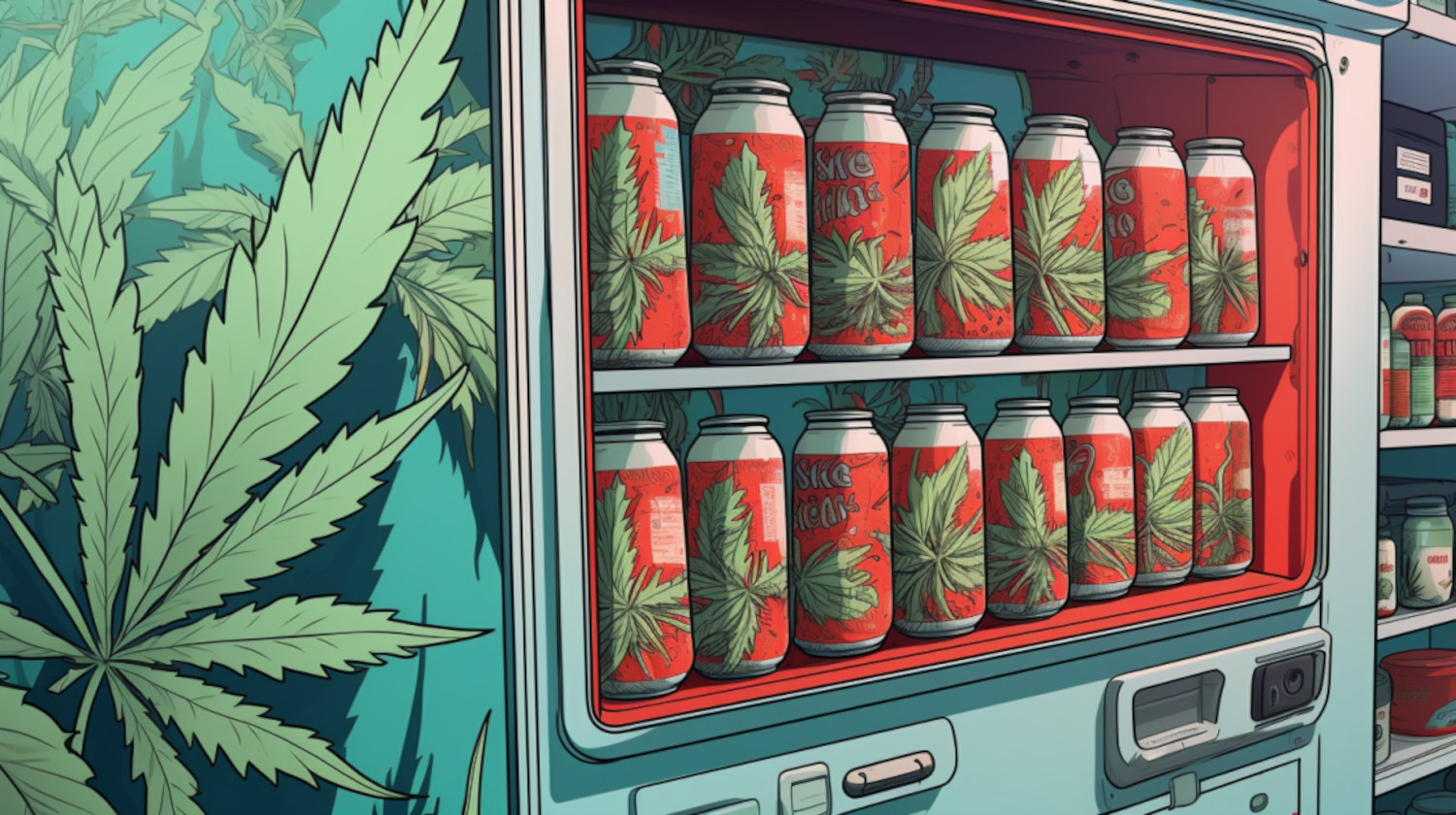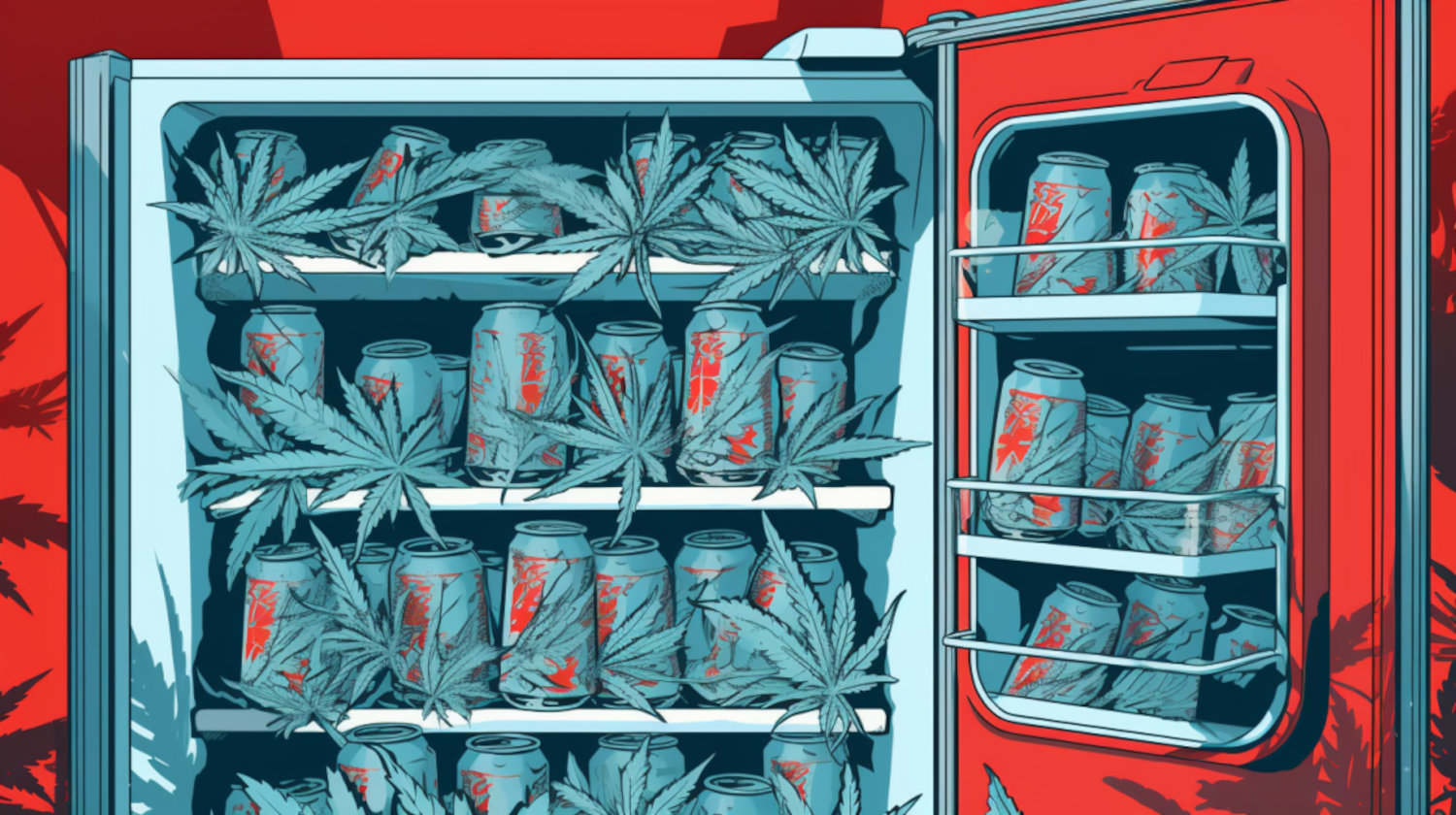-
What you will learn in this post:
Wine and weed connoisseurs have found common ground with cannabis infused wine. Infused beverages have grown from a home hobby beverage to a booming retail market, surpassing $200 million in 2022.
Although wine has been served as a ceremonial, curative, and celebratory beverage for thousands of years, studies emerged in 2018 touting the health benefits of red wine. Consuming a moderate amount improves good HDL cholesterol, reduces cancer risk, and may prevent cardiovascular disease.1 An antioxidant, resveratrol, came forward as the link to benefits from wine consumption.
Now, weed infused wine debuted in the recreational world, possibly blending the health advantages of wine with the therapeutic value of THC and other cannabinoids.
What is Weed Wine?
Weed wine is a beverage that combines the elements of cannabis with traditional wine.
There are two types of weed wine: non-alcoholic and alcoholic. Cannabis infused wine sold commercially is strictly non-alcoholic due to federal laws that regulate alcohol and prohibit the blending of two different intoxicants.
CBD infused alcohol-free wine is available in many states and online. If you’d like a boost of THC in your non-alcoholic wine, there may be options currently available at dispensaries only.
Due to legal restrictions, you won’t find commercially available alcoholic wine topped off with THC. However, home winemakers have created an underground art of vinting (making wine) with cannabis, allowing fermenting grapes to mix with cannabis flowers, creating a double-buzzy wine. Others use a shortcut of simmering cannabis in existing wine, decarbing the flower as it melds with the alcohol.
Weed wine takes on the characteristics of the base wine, from dry to sweet. The strength of the cannabis flavor depends on the infusion method and aging time.
The effects of non-alcoholic weed wine come solely from the addition of cannabinoids, with THC producing an edible-intoxication effect or CBD for relaxation without intoxication. Alcohol and cannabis used together intensify the effects of each and can cause heightened impairment. When drinking an alcohol-based cannabis wine, the delayed impact of consuming THC may lead to cross-fading, an unpleasant experience of being both drunk and high at the same time. A slow-sipping approach might be best.
Benefits of Weed Wine

Enjoying a glass of wine with a friend is sociable and fun and can have physical health benefits, too. Responsible consumption of weed infused wine can join the relaxing effects of wine with the potential medicinal effects of cannabis.
When made with red wine, weed infused wine may offer cancer prevention and improved cardiovascular and neurological health. Moderate consumption of red wine with food provides healthy antioxidants and plant polyphenols, including resveratrol and anthocyanins.
Resveratrol is in grape skins that are used in winemaking. Rich in antioxidants, resveratrol neutralizes free radicals and reduces oxidative stress, protecting against chronic conditions like cancer and cardiovascular disease.
Anthocyanins occur in brightly colored fruits and veggies, like apples, berries, and grapes. In addition to similar protective properties like resveratrol, anthocyanins may modulate gut microbiota, encouraging the growth of helpful stomach microbes.2
Medicating with cannabis using weed wine also offers advantages. THC wine at the dispensary falls under the edibles category and shares similar potential benefits. Dispensary beverages are tested and labeled with the amount of THC per product or serving to allow for accurate medical dosing. Legally purchased products have been tested and come with a certificate of analysis (CoA) to verify quality regulated production.
Like edibles, weed wine may take 30 to 90 minutes to take effect and can offer extended relief. Alcoholic wine and weed can produce a two-phase impact, with the alcohol intoxication preceding the THC rush, so pace yourself accordingly!
Finally, like other edibles, weed wine allows medicating without smoking for those concerned about the respiratory risks associated with inhalables.
Weed wine, including both THC wine and weed infused wine, offers a unique blend of the traditional benefits of wine and the therapeutic potential of cannabis. As the popularity of cannabis beverages grows, more research will undoubtedly follow.
Drawbacks of Weed Wine
Choosing an alcoholic weed wine does have drawbacks.
The combination of alcohol and cannabis can have an overlapping effect. This outcome can be fun or silly unless you’ve overserved yourself. The dual impact of alcohol and weed can cause cross-fading, a very unpleasant combination of symptoms, including nausea, sweating, anxiety, and disorientation. Motor skills and cognitive function can be affected, too, so this isn’t the time to drive yourself or anyone else home. Being mindful and slow in drinking alcohol-based weed wine, along with staying hydrated, can help you avoid unwelcome consequences.
Doubling up on cannabis and alcohol can increase the effects of either substance alone. Blood concentration of THC and alcohol can increase the intensity and duration of impairment, particularly affecting behavioral and cognitive functions. The combination of alcohol and weed can amplify the effects of both, causing you to feel much more impaired than you would with just alcohol or cannabis alone.3
Unlike cannabis, you can overdose on alcohol. Since weed wine made with alcohol may intoxicate you more rapidly than you expect, watch your consumption and avoid high-intensity drinking.
What You Need to Make Weed Wine

Making weed wine at home can be an enjoyable hobby. There are two ways to create cannabis wine. You can infuse existing wine with cannabis or make wine from scratch, infusing cannabis during the winemaking process.
Making wine from scratch is lengthy and involves a lot of effort.
The process looks straightforward on paper: smash grapes, add yeast, and allow the mixture to ferment. It's ready to drink once it’s clarified, aged, and bottled.
In reality, making wine at home requires patience and an appreciation for chemistry. The steps from fruit to fruition are complex, and attention to detail will produce a safe and drinkable bottle of wine.
If you love a do-it-yourself challenge, a home brewing or wine-making supply store will have the necessary advice and equipment. Kits are also available online. A basic winemaking setup includes:
- A food-grade plastic fermenting pail: To mix ingredients and conduct the initial fermentation.
- Plastic or glass carboy: A large narrow-neck bottle to contain the second fermentation
- Air-lock: A specialized one-way stopper to release fermenting gas bubbles without allowing air to enter the carboy
- Plastic tubing: To transfer wine to the carboy and bottles
- Long-handled plastic spoon: For mixing
- Thermometer and Hygrometer: To maintain temperature and measure fermentation and sugar content of the wind
- Bottling and sanitizing equipment
You’ll also need cannabis. You can use flower from your favorite strain, but trim and stems work, too. Depending on the recipe, you’ll need a few ounces or more. You can use raw cannabis for a mellower effect or decarb the cannabis before adding it to the fermenting wine for more punch. If you use a dry herb vaporizer, save your already-been-vaped (ABV) weed in a cool, dry container until ready to use. ABV weed is an economical alternative to fresh weed, doesn’t need to be decarbed, and has potency left to give your wine, or any edibles, a kick.
Beginner wine-making sets are available online for $100-$200. For precise instructions on how to make cannabis wine, check your local community for classes, home vintner groups, or research recipes online.
The wine-making process will take at least 45 days from start to finish, although experienced vintners suggest aging wines for several months or more.
For more immediate gratification, or if you want to try out homemade THC wine before investing in wine-making equipment, you can make a very decent “homemade” wine in just a few hours.
How to Make Weed Wine
Cannabis-infused wine can be made in the afternoon for a party at night. Compared to making wine from scratch, this cannabis wine-making method is simple.
Begin with an ounce of weed. If you are using ABV weed, there is no need to decarboxylate it. If you are using raw flower, you’ll convert the THCA to potent THC by baking your weed in the oven at 230°-250°F for 25-30 minutes. You can also use trim or stems.
To make cannabis-infused wine:
Ingredients:
- 1 ounce (about 28 grams) decarbed flower, ABV flower, or trim
- 1 bottle of good red wine
- 1 orange, sliced
- 4 cloves
- ¼ tsp of nutmeg
- ¼ of cardamom
- ½ teaspoon of ground cinnamon
- Cheesecloth or paper coffee filters
Note: Spices are optional, but add a nice flavor.
Instructions:
- Put all your ingredients in a large pot. Gently simmer the mixture for two hours.
- Strain the wine through the cheesecloth or coffee filter.
- Let cool. If you prefer, refrigerate for two to two and a half hours until it reaches 55°-60°F.
- Serve!
If you prefer, you can use raw flower without decarboxylation, although you’ll have less cannabis potency in your wine.
Tips for Buying Weed Wine

Whether you're a wine connoisseur, a cannabis enthusiast, or simply curious, weed wine can be a friendly way to enjoy a cannabis session. Before diving into your first cannawine purchase, here are some helpful tips on what to look for:
- Under current federal law, wine with an alcohol content above 0.5% cannot be blended with THC and sold commercially. You can purchase alcohol-free wine infused with THC at dispensaries in some states.
- Dispensary purchases should offer a certificate of analysis (COA) to guarantee quality and safety. Labeling should include percentages of each cannabinoid to guide how much THC you’ll consume by liquid ounce. The COA also assures that your weed wine contains no pesticides or contaminants.
- CBD wine, both alcohol-free and with alcohol, is available and legal to sell in most states. Since CBD is a non-intoxicating cannabinoid, mixing it with alcoholic beverages is allowed. Many restaurants offer CBD wines by the glass, both with and without alcohol.
- Weed wine is an emerging market in the US, and new producers join the market every day. Following a few consumer suggestions, you can discover a weed wine that appeals to your palate.
- Weed wine is comparable to other mid-price wines, most in the $20-$60 per bottle range. Wine cost doesn’t always indicate quality, so try wines in your price range. Wine producers are creating favorite alcohol-free varieties with CBD so that you won’t give up taste for the benefit of cannabis. When shopping, look for recognized brands and reputable reviews. Opt for weed wines made with natural ingredients; the fewer additives will give the wine a more authentic taste and flavor.
Consume weed wine responsibly. Remember, the combined effects of alcohol and THC can be more potent than anticipated. CBD can affect the potency and effectiveness of some medications, so if in doubt, check with your healthcare provider before consuming. Explore, enjoy, and always be mindful of your choices.
References
- Snopek L, Mlcek J, Sochorova L, et al. Contribution of Red Wine Consumption to Human Health Protection. Molecules. 2018;23(7):1684. Published 2018 Jul 11. doi:10.3390/molecules23071684 ↩︎
- Mattioli R, Francioso A, Mosca L, Silva P. Anthocyanins: A Comprehensive Review of Their Chemical Properties and Health Effects on Cardiovascular and Neurodegenerative Diseases. Molecules. 2020;25(17):3809. doi:https://doi.org/10.3390/molecules25173809 ↩︎
- Yurasek AM, Aston ER, Metrik J. Co-use of Alcohol and Cannabis: A Review. Curr Addict Rep. 2017;4(2):184-193. doi:10.1007/s40429-017-0149-8 ↩︎
The information in this article and any included images or charts are for educational purposes only. This information is neither a substitute for, nor does it replace, professional legal advice or medical advice, diagnosis, or treatment. If you have any concerns or questions about laws, regulations, or your health, you should always consult with an attorney, physician or other licensed professional.




